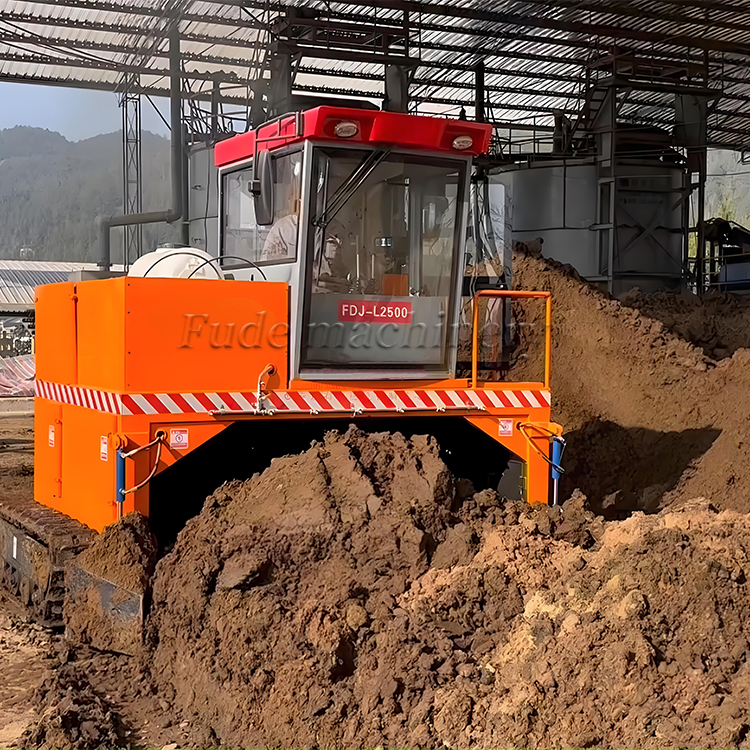Organic fertilizer turning rake machine
440Usually fixed on the guide rail of the fermentation tank, it is driven by electricity to move back and forth on the track of the fermentation tank for flipping operations.
View detailsSearch the whole station
Crawler compost turners are self-propelled machines that travel over compost windrows. They use a rotating drum with teeth to lift, mix, aerate, and crush the organic material, significantly speeding up the composting process and ensuring uniformity.
Turning organic waste into valuable fertilizer is essential, but traditional methods can be slow and labor-intensive. Inefficient composting leads to nutrient loss, odor problems, and inconsistent product quality. Finding a better way to manage this process is crucial for large farms and fertilizer producers. As manufacturers at Zhengzhou Fude Machinery, we understand these challenges and provide robust solutions like our crawler compost turners to enhance your operations. Let’s explore how this technology can make a difference.
Are you facing issues like foul odors or slow decomposition in your compost piles? Do you wonder how to achieve consistently high temperatures? The crawler turner is designed specifically to manage the critical factors in composting.
Its primary role is to thoroughly mix, aerate (introduce oxygen), crush clumps, and homogenize the compost windrow. This optimizes conditions for the aerobic microorganisms responsible for decomposition.
The success of aerobic composting hinges on maintaining the right environment for beneficial microbes. These microbes need oxygen, moisture, and access to the organic material to work efficiently. A crawler compost turner acts as the primary tool to manage this environment within a windrow system. Without effective turning, the process slows dramatically, and undesirable anaerobic conditions can develop.

Are you weighing different options for turning your compost? Is the investment in a crawler turner justified? Understanding its unique benefits compared to alternatives is key to making an informed decision.
Several methods exist for managing compost, ranging from simple static piles to highly engineered systems. The crawler compost turner occupies a niche offering a balance of efficiency, flexibility, and cost-effectiveness, particularly for medium to large-scale windrow operations. Let’s compare it directly to common alternatives:
Do you work with animal manure, crop residues, or sludge? Need confirmation if a crawler turner can process your specific waste stream? Knowing the machine’s capabilities with different materials is important.
Crawler turners effectively handle a wide range of organic materials common in fertilizer production, including livestock manures (cow, chicken, pig), sewage sludge, mushroom substrate, straw, and other agricultural wastes.




While versatile, crawler turners may struggle with:
Crawler turners improve quality by ensuring thorough aerobic decomposition, leading to stable humus, pathogen reduction, uniform texture, consistent moisture, and fewer weed seeds.
The quality of organic fertilizer or compost is judged by several factors: nutrient content and stability, pathogen levels, weed seed viability, texture, moisture content, and maturity. The intensive mixing and aeration provided by a crawler compost turner directly contribute to improvements in nearly all these areas.


Ready to select a machine but unsure what specs matter most? How do you compare different models effectively? Focusing on the key parameters ensures you get a machine that truly meets your needs.
Key parameters include turning width and height (matching windrow size), processing capacity (m³/hr), engine power, turning drum design (effectiveness), and crawler system reliability for maneuverability.
Seeing various models offered? Wondering how a smaller one differs from a larger one in practice? Different sizes are tailored for distinct operational scales and needs.
Models primarily differ in size (width, height) and processing capacity. Smaller models suit large farms or smaller commercial plants, while larger models are for high-volume municipal or industrial composting facilities.
Crawler compost turners are not one-size-fits-all. Manufacturers like us at Zhengzhou Fude Machinery offer a range of models to cater to the diverse scales of organic waste generation and processing. The primary distinctions lie in their physical dimensions and throughput capacity, which dictate their ideal application scenarios.
Crawler compost turners truly revolutionize organic fertilizer production. They accelerate composting, reduce costs, and significantly improve the final product quality through efficient aeration and mixing.
Usually fixed on the guide rail of the fermentation tank, it is driven by electricity to move back and forth on the track of the fermentation tank for flipping operations.
View detailsChain plate overturning machine is suitable for multi tank aerobic fermentation process in composting production
View detailsThere are various types of flipping machines, each with its own characteristics and applicable scenarios
View detailsThere are significant differences in the structure, working principle, scope of application, and other characteristics between the type flipping machine and the chain plate flipping machine
View details